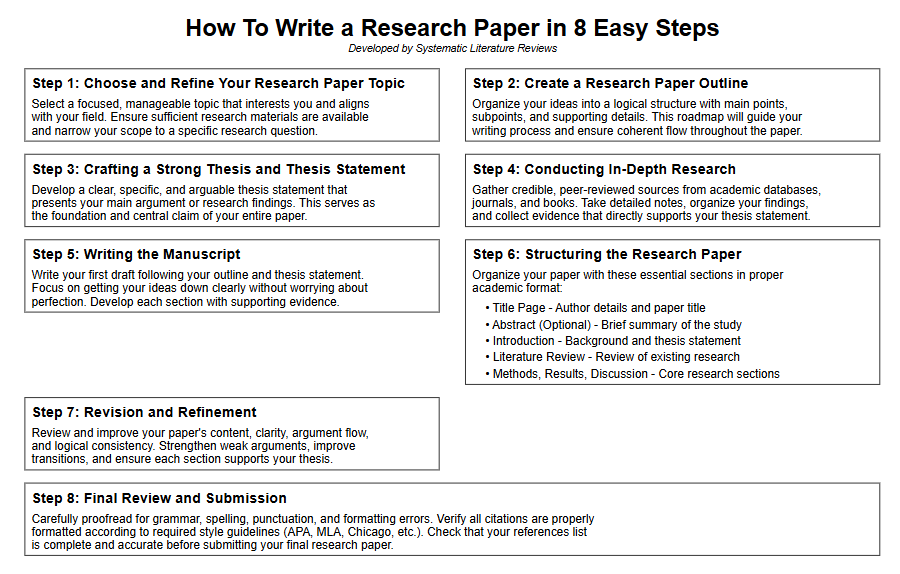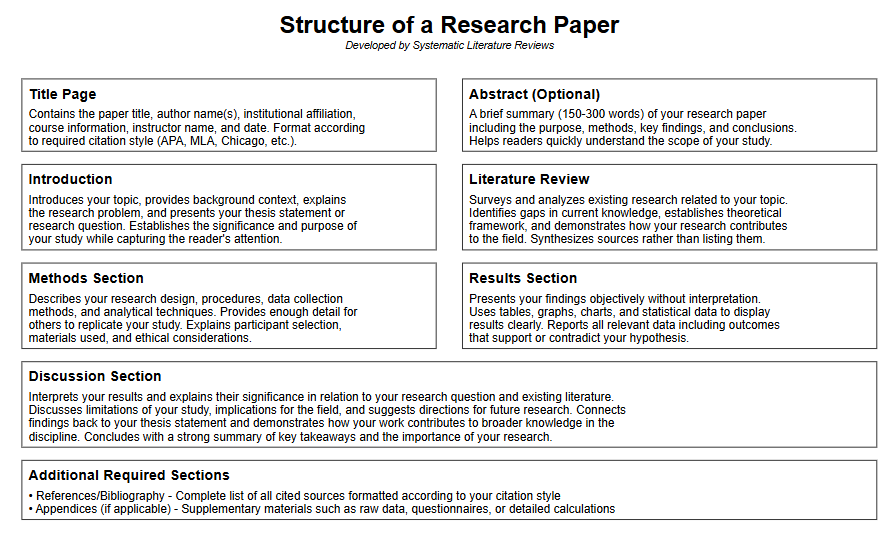Blog
How to Write a Research Paper: A Step-by-Step Guide to Academic Writing and Completing a Research
What Is a Research Paper?
- Definition:
A research paper is a piece of academic writing that presents an original argument, interpretation, or evaluation based on evidence-based practice. It differs from a regular essay because it contributes new insights to the scientific community and is grounded in academic research. - Purpose:
The main goal of learning how to write a research paper is to demonstrate critical thinking, analysis, and synthesis of primary sources and secondary sources. Many students begin by misunderstanding the process, believing it’s only about summarizing facts. However, writing a paper involves analyzing relevant information, formulating a research question, and presenting findings with supporting evidence. - Characteristics:
- Written in a clear and concise manner.
- Organized into sections with headings.
- Includes citation style formatting such as APA or MLA.
- Incorporates figures and tables, statistical tests, and a results section.
- Demonstrates understanding of academic writing conventions.
- Learning how to write a research paper step-by-step helps students revise misconceptions, apply in-depth reasoning, and present their work following strict formatting guidelines.
- Want to learn more? Explore our detailed blogs on systematic reviews and meta-analysis to deepen your understanding of advanced research paper writing methods and strengthen your evidence-based academic skills.

Writing a Research Paper in 8 Easy Steps
Step 1: Choose and Refine Your Research Paper Topic
- Choosing a Topic:
Begin the writing process by brainstorming ideas. Choose a topic that’s manageable within your timeframe and aligns with your academic goals. A focused research paper topic prevents data and complexity from overwhelming your structure. - Refining the Topic:
- Start broad, then refine the idea into a specific research question.
- Ensure it allows for in-depth exploration and measurable supporting evidence.
- Avoid overly general subjects—effective research paper writing requires precision.
- Preliminary Research:
Conduct preliminary reading from journals or academic papers and databases to understand existing literature. Use primary sources for firsthand accounts and secondary sources for critical reviews.
Example: Before learning how to write a research paper on climate change, explore prior studies on greenhouse gas impacts and sustainability. - Checklist:
- Is the topic current and researchable?
- Are there enough tools and resources available?
- Does it align with your academic writing goals?
Step 2: Create a Research Paper Outline
- Importance of the Outline:
A research paper outline is a comprehensive guide that structures your manuscript into logical parts. Many students skip this outline phase, leading to structural issues later. - Building the Outline:
- Organize ideas chronologically or by subtopics.
- Include placeholders for introduction, literature review, methods section, results section, and discussion section.
- Convert the outline into paragraphs as you start writing.
- APA and MLA Considerations:
Whether using APA format or MLA format, the outline helps maintain consistency with page numbers, headings, and citation alignment. - Tip:
The more detailed your research paper outline, the easier it becomes to write a research paper smoothly and revise effectively.
Step 3: Crafting a Strong Thesis and Thesis Statement
- Defining the Thesis:
A thesis represents the central claim your paper defends. In how to write a research paper, this is the backbone that holds all arguments together. - Creating a Thesis Statement:
- Keep it clear and concise.
- Present your stance and hypothesis succinctly.
- Avoid passive voice; use direct, academic tone.
- Example:
Poor: “This paper will talk about stress in students.”
Strong: “Academic workload significantly contributes to student stress, as shown by statistical tests and survey data.” - Checklist for a Strong Thesis Statement:
- Arguable, not factual.
- Supported by evidence-based practice.
- Directly tied to your research question.
Step 4: Conducting In-Depth Research
- Gathering Evidence:
Write research based on credible primary and secondary sources. Use university databases, Google Scholar, and library archives. - Tools and Resources:
- Journals or academic papers for peer-reviewed content.
- Reference managers like Zotero or EndNote for citation.
- Statistical software or spreadsheet tools for data and graphs.
- Evaluating Sources:
Ask whether the information is reliable, current, and relevant. How to write a research paper involves verifying credibility before citing. - Recording Citations:
Cite every source properly in your notes. Use APA or MLA citation style to avoid plagiarism. - Supporting Evidence:
Always link findings to your hypothesis. Include figures and tables later to illustrate patterns clearly.
Research Paper Help
- Expert Academic Research Writers
- High-Quality Evidence-Based Reviews
- Accurate APA/Harvard Referencing
Get Free Consultation
- Personalized Expert Guidance
- No Hidden Consultation Fees
- Tailored Research Strategy Planning
Step 5: Writing the Manuscript – Step-by-Step Writing Process
- Start Writing:
Begin drafting your manuscript by expanding your outline into paragraphs. Keep sentences clear and concise while ensuring enough detail for understanding. - Writing Process Tips:
- Maintain academic writing tone.
- Use transition words between sections with headings.
- Incorporate supporting evidence naturally.
- Citation and Format:
Use APA format or MLA format consistently. Each paragraph should connect with your thesis statement and research question. - Avoid Plagiarism:
Paraphrase secondary sources, and always cite directly when quoting. How to write a research paper correctly means producing original analysis while crediting authors. - Proofread and Revise:
After completing a research draft, revise grammar, clarity, and flow. Eliminate grammatical errors and passive voice.
Step 6: Structuring the Research Paper
A well-organized paper ensures coherence and credibility. Each section contributes uniquely to an effective research paper.

Title Page
- Follow APA format for structure: Title, Author, Institution, Course, Instructor, Date.
- The title page sets the first impression—ensure formatting guidelines are followed precisely.
Abstract (Optional)
- A succinctly written overview of your manuscript.
- Summarize purpose, methods section, and results section briefly.
- Limit to 150–250 words depending on formatting style.
Introduction Section
- Provide background information and justify the research question.
- Explain the thesis and objectives.
- Avoid irrelevant details—focus on relevant information that leads into the literature review.
Literature Review
- Summarize primary sources and secondary sources.
- Identify patterns, gaps, or contradictions.
- Demonstrate your awareness of academic research trends.
- In how to write a research paper, the literature review shows understanding of previous critical reviews.
Methods Section
- Describe how you collected data and conducted statistical tests.
- Present enough detail for replication.
- Specify materials, tools and resources, and procedures.
- The methods section is essential in any piece of academic writing that values transparency.
Results Section
- Display findings with tables and figures.
- Include graphs, charts, and summaries of statistical outcomes.
- Report without interpretation—save explanations for the discussion section.
Discussion Section
- Interpret what the results section means in context.
- Compare findings to the hypothesis and prior studies.
- Mention directions for future research.
- Use supporting evidence to reinforce arguments.
Step 7: Revision and Refinement
- Why Revise:
Revision ensures your manuscript meets academic writing standards. Even experienced scholars continually revise for clarity. - Checklist for Refinement:
- Review for grammatical errors and sentence flow.
- Ensure each paragraph supports the thesis.
- Maintain citation consistency in APA or MLA.
- Replace vague phrases with clear and concise wording.
- Ensure tables and figures are labeled and referenced properly.
- Proofread for Quality:
Read aloud or use proofreading software. Remember: how to write a research paper well includes revisiting every section critically.
Step 8: Final Review and Submission
- Final Review:
- Confirm page numbers, formatting style, and margins meet APA standards.
- Verify citation style consistency.
- Double-check the title page, headers, and outline structure.
- Submission Tips:
- Ensure revision has corrected all structural issues.
- Attach appendices or supplementary figures and tables if needed.
- Confirm that all supporting evidence is cited.
- Post-Submission Reflection:
Reflect on what you learned from completing a research. How to write a research paper successfully means mastering analysis, organization, and precision that contribute to professional growth in the scientific community.
Key Takeaways: How to Write a Research Paper
- Learning how to write a research paper helps students develop strong academic writing and critical thinking skills.
- Always choose a manageable topic and conduct preliminary research using credible primary and secondary sources.
- Create a detailed research paper outline before writing to maintain structure and logical flow.
- A strong thesis statement should clearly express your main argument and guide the entire paper.
- Follow a step-by-step writing process using the correct APA or MLA citation style to avoid plagiarism.
- Include key sections: title page, literature review, methods section, results section, and discussion section.
- Present tables and figures clearly, ensuring accurate statistical data and explanations.
- Use tools and resources to enhance organization, formatting, and referencing accuracy.
- Revise, proofread, and perform final revision to correct grammatical errors and improve clarity before submission.
